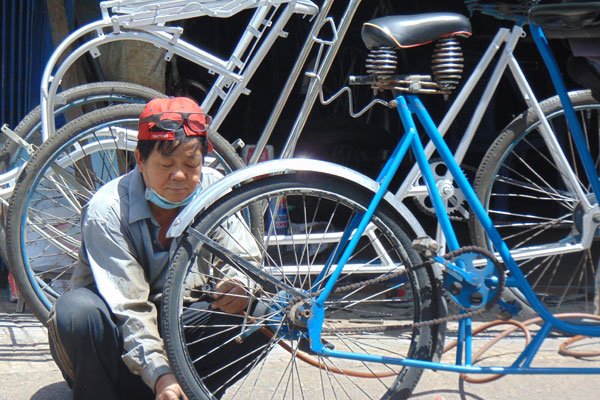For older generations, the pedicab used to be a popular means of transportation on every street corner of old Saigon in previous decades.
The rudimentary transport means has become a unique cultural trait of Saigonese and is attached to many people’s childhoods.
However, due to the socio-economic development, the three-wheeled rickshaw has gradually fallen into oblivion and given way to taxis and buses.
Currently, there remain few pedicabs in the city now, mainly at luxury hotels to serve well-to-do visitors wanting to have a leisure sightseeing tour in the city.
But there remains at least a special man who has been sticking with his job as a pedicab repairman for nearly 40 years at the heart of the city.
Ho Tan Phat, who was born and brought up in the land of Saigon, still takes pride in the trivial-income job he has pursued for nearly four decades. Phat does not simply sees the job as a way to earn his daily bread. Instead, he has nurtured a special love for the outdated pedicab and a strong desire to treasure old memories and unique cultural features about the image of a cyclo attached to the ups and downs of the city.
Also known as Sau Phat, the 62-year-old man has rented a small home at 206 Tran Phu Street in District 5, HCMC to open his pedicab-repairing shop.
“Everyday I can earn VND100,000 to VND120,000 which is only enough to cover the rental plus power and water bills, and on some days there are no customers at all. Repairing cyclos no longer brings me a stable income but I still stick to the job just to meet with friends to chat for fun and live in peace day by day,” says Phat, one among very few cyclo repairmen in the city.

Ho Tan Phat, a 62-year-old man, sticks with his job as a pedicab repairman for nearly 40 years at 206 Tran Phu Street in District 5, HCMC
Recalling the early days of his job, Phat says he came upon the occupation all by accident. Before betting his life with the job of repairing cyclo at the age of 22, Phat worked as a bicycle repairman at the corner of Nguyen Trai and Tran Binh Trong streets in HCMC’s District 5.
“In Saigon, the pedicab saw its heyday in the 80s when the three-wheeled vehicle beat taxis and buses for the top slot in the public transport system. Many Saigonese, especially housewives and elderly people, opted for a cyclo for short tours. Therefore, I decided to shift to the pedicab-repairing job with a hope to earn a decent income to support my family of four and help my two children to gain better access to formal education,” Phat says.
“It may take one to three days to finish repairing a cyclo for customers and like other occupations, this job requires workers to be patient, hard-working, and skillful. It is not at all easy in the first days of working,” Phat explains.
But since 2008, when the municipal authorities issued a ban on the three-wheeled vehicle moving onto downtown streets, his business has gradually become gloomier as the majority of cyclo drivers quitted the job and found other ways to earn a living.
Currently, the pedicab is no longer popular on street corners of the city and is mainly used for tourism purposes to serve foreign visitors wishing to gain hands-on experience in this vehicle and for transporting vendors and large packages of goods to markets.
The image of the 62-year-old Phat sitting to repair pedicabs on Tran Phu Street is regarded by some as a hidden gem amidst the hustle and bustle of modern city life and contributes to enriching cultural life of Saigonese.
SGT